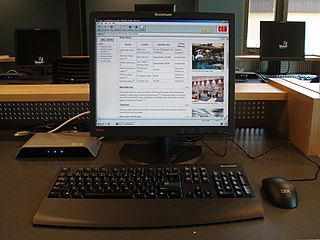
In computer networking, a thin client, sometimes called slim client or lean client, is a simple (low-performance) computer that has been optimized for establishing a remote connection with a server-based computing environment. They are sometimes known as network computers, or in their simplest form as zero clients. The server does most of the work, which can include launching software programs, performing calculations, and storing data. This contrasts with a rich client or a conventional personal computer; the former is also intended for working in a client–server model but has significant local processing power, while the latter aims to perform its function mostly locally.

The X Window System is a windowing system for bitmap displays, common on Unix-like operating systems.

VNC is a graphical desktop-sharing system that uses the Remote Frame Buffer protocol (RFB) to remotely control another computer. It transmits the keyboard and mouse input from one computer to another, relaying the graphical-screen updates, over a network. Popular uses for this technology include remote technical support and accessing files on one's work computer from one's home computer, or vice versa.
TightVNC is a free and open-source remote desktop software server and client application for Linux and Windows. A server for macOS is available under a commercial source code license only, without SDK or binary version provided. Constantin Kaplinsky developed TightVNC, using and extending the RFB protocol of Virtual Network Computing (VNC) to allow end-users to control another computer's screen remotely.
RealVNC is a company that provides remote access software. Their VNC Connect software consists of a server and client application, which exchange data over the RFB protocol to allow the Viewer to control the Server's screen remotely. The application is used, for example, by IT support engineers to provide helpdesk services to remote users.
NX technology, commonly known as NX or NoMachine, is a remote access and remote control computer software allowing remote desktop access and maintenance of computers. It is developed by the Luxembourg-based company NoMachine S.à r.l. NoMachine is proprietary software and is free-of-charge for non-commercial use.
Remote administration refers to any method of controlling a computer or other Internet-connected device, such as a smartphone, from a remote location. There are many commercially available and free-to-use software that make remote administration easy to set up and use. Remote administration is often used when it's difficult or impractical to be physically near a system in order to use it or troubleshoot it. Many server administrators also use remote administration to control the servers around the world at remote locations. It is also used by companies and corporations to improve overall productivity as well as promote remote work. It may also refer to both legal and illegal remote administration.

Apple Remote Desktop (ARD) is a Macintosh application produced by Apple Inc., first released on March 14, 2002, that replaced a similar product called Apple Network Assistant. Aimed at computer administrators responsible for large numbers of computers and teachers who need to assist individuals or perform group demonstrations, Apple Remote Desktop allows users to remotely control or monitor other computers over a network. Mac Pro (2019), Mac mini with a 10Gb Ethernet card, and Mac Studio (2022) have Lights Out Management function and are able to power-on by Apple Remote Desktop.

UltraVNC is an open-source remote-administration/remote-desktop-software utility. The client supports Microsoft Windows and Linux but the server only supports Windows. It uses the RFB (VNC) protocol to allow a computer to access and control another one remotely over a network connection.
VirtualGL (VGL) is an open-source software package that redirects the 3D rendering commands from Unix and Linux OpenGL applications to 3D accelerator hardware in a dedicated server and sends the rendered output to a (thin) client located elsewhere on the network. On the server side, VirtualGL consists of a library that handles the redirection and a wrapper program that instructs applications to use this library. Clients can connect to the server either using a remote X11 connection or using an X11 proxy such as a Virtual Network Computing (VNC) server. In case of an X11 connection some client-side VirtualGL software is also needed to receive the rendered graphics output separately from the X11 stream. In case of a VNC connection no specific client-side software is needed other than the VNC client itself.

In systems management, out-of-band management is a process for accessing and managing devices and infrastructure at remote locations through a separate management plane from the production network. OOB allows a system administrator to monitor and manage servers and other network-attached equipment by remote control regardless of whether the machine is powered on or whether an OS is installed or functional. It is contrasted to in-band management which requires the managed systems to be powered on and available over their operating system's networking facilities.

Desktop virtualization is a software technology that separates the desktop environment and associated application software from the physical client device that is used to access it.
A home server is a computing server located in a private computing residence providing services to other devices inside or outside the household through a home network or the Internet. Such services may include file and printer serving, media center serving, home automation control, web serving, web caching, file sharing and synchronization, video surveillance and digital video recorder, calendar and contact sharing and synchronization, account authentication, and backup services. In the recent times, it has become very common to run hundreds of applications as containers, isolated from the host operating system.
In computing, the term remote desktop refers to a software- or operating system feature that allows a personal computer's desktop environment to be run remotely from one system, while being displayed on a separate client device. Remote desktop applications have varying features. Some allow attaching to an existing user's session and "remote controlling", either displaying the remote control session or blanking the screen. Taking over a desktop remotely is a form of remote administration.
This page is a comparison of notable remote desktop software available for various platforms.

ThinLinc is a cross-platform remote desktop server developed by Cendio AB. The server software and the users' main desktops run on Linux. Clients are available for Linux, Windows, macOS, and a number of thin clients. A browser client using HTML5 technologies is also available.
Remote Desktop Services (RDS), known as Terminal Services in Windows Server 2008 and earlier, is one of the components of Microsoft Windows that allow a user to initiate and control an interactive session on a remote computer or virtual machine over a network connection. RDS was first released in 1998 as Terminal Server in Windows NT 4.0 Terminal Server Edition, a stand-alone edition of Windows NT 4.0 Server that allowed users to log in remotely. Starting with Windows 2000, it was integrated under the name of Terminal Services as an optional component in the server editions of the Windows NT family of operating systems, receiving updates and improvements with each version of Windows. Terminal Services were then renamed to Remote Desktop Services with Windows Server 2008 R2 in 2009.
CrossLoop was a remote desktop service from CrossLoop Inc., which allowed users to share their computer screens and collaborate with others over the Internet.

Chrome Remote Desktop is a remote desktop software tool, developed by Google, that allows a user to remotely control another computer's desktop through a proprietary protocol also developed by Google, internally called Chromoting. The protocol transmits the keyboard and mouse events from the client to the server, relaying the graphical screen updates back in the other direction over a computer network. This feature, therefore, consists of a server component for the host computer, and a client component on the computer accessing the remote server. Chrome Remote Desktop uses a unique protocol, as opposed to using the common Remote Desktop Protocol.
Remote mobile virtualization, like its counterpart desktop virtualization, is a technology that separates operating systems and applications from the client devices that access them. However, while desktop virtualization allows users to remotely access Windows desktops and applications, remote mobile virtualization offers remote access to mobile operating systems such as Android.







